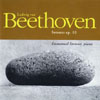Beethoven Piano Sonatas, Op 10
Attractive ebullience and incisiveness can sometimes replace intensity and depth
View record and artist detailsRecord and Artist Details
Composer or Director: Ludwig van Beethoven
Label: Assai
Magazine Review Date: 2/2001
Media Format: CD or Download
Media Runtime: 60
Catalogue Number: 222072

Tracks:
| Composition | Artist Credit |
|---|---|
| Sonata for Piano No. 5 |
Ludwig van Beethoven, Composer
Emmanuel Strosser, Piano Ludwig van Beethoven, Composer |
| Sonata for Piano No. 6 |
Ludwig van Beethoven, Composer
Emmanuel Strosser, Piano Ludwig van Beethoven, Composer |
| Sonata for Piano No. 7 |
Ludwig van Beethoven, Composer
Emmanuel Strosser, Piano Ludwig van Beethoven, Composer |
Author: Tim Parry
This is young person’s Beethoven. I don’t mean that at all patronisingly – after all, this is relatively youthful, high-spirited Beethoven – but only to suggest its primary characteristics, which are more dynamic than reflective. Emmanuel Strosser, who hails from Strasbourg, plays Beethoven’s Op 10 sonatas with bundles of energy and vigour, and his athleticism and taut rhythmic control are conveyed with the utmost conviction. From the opening of the C minor Sonata, Op 10 No 1, you have an idea of Strosser’s crisp attack and bold propulsive energy, and this is a feature of his approach to all three sonatas. However, he treads a fine line between boldness and aggression, and there is a relentlessness to his approach that occasionally undermines much very good playing. The C minor Sonata is given a more brusque treatment than the other two works; in the F major Sonata, Op 10 No 2, Strosser more successfully balances playful brio and dramatic incisiveness, while in the D major he brings a more inward disposition and softer colours.
To my mind, Strosser is least convincing when the music is at its simplest or most lyrically expressive. The slow movement of the C minor Sonata, for example, doesn’t take wing, and there is much more emotional depth to be found in the magical Largo e mesto of Op 10 No 3. I was keen to compare Strosser to another young pianist, so chose Barenboim’s first recording (EMI, 10/90, only available in a 10-disc set); the difference – in expressive range, dynamic nuance, tonal resource and general musical flexibility – is immediately evident, in the slow movements especially. It’s not that Strosser is uncommunicative or inexpressive, just that Barenboim conveys a greater degree of passion and expressive tension, and sustains Beethoven’s broader structural spans (as in the D major Sonata’s Largo) with a more gripping intensity. The recorded sound is bright and open, but the hideous cover is hardly enticing.'
To my mind, Strosser is least convincing when the music is at its simplest or most lyrically expressive. The slow movement of the C minor Sonata, for example, doesn’t take wing, and there is much more emotional depth to be found in the magical Largo e mesto of Op 10 No 3. I was keen to compare Strosser to another young pianist, so chose Barenboim’s first recording (EMI, 10/90, only available in a 10-disc set); the difference – in expressive range, dynamic nuance, tonal resource and general musical flexibility – is immediately evident, in the slow movements especially. It’s not that Strosser is uncommunicative or inexpressive, just that Barenboim conveys a greater degree of passion and expressive tension, and sustains Beethoven’s broader structural spans (as in the D major Sonata’s Largo) with a more gripping intensity. The recorded sound is bright and open, but the hideous cover is hardly enticing.'
Discover the world's largest classical music catalogue with Presto Music.

Gramophone Digital Club
- Digital Edition
- Digital Archive
- Reviews Database
- Full website access
From £8.75 / month
Subscribe
Gramophone Full Club
- Print Edition
- Digital Edition
- Digital Archive
- Reviews Database
- Full website access
From £11.00 / month
Subscribe
If you are a library, university or other organisation that would be interested in an institutional subscription to Gramophone please click here for further information.




